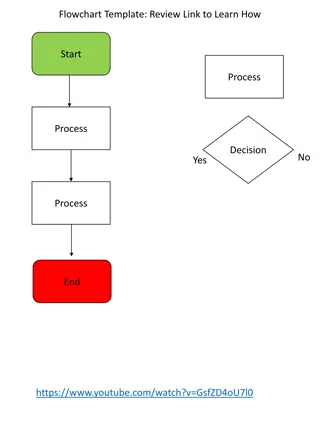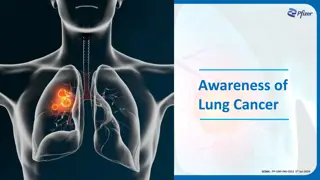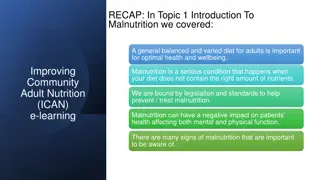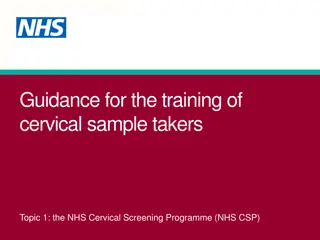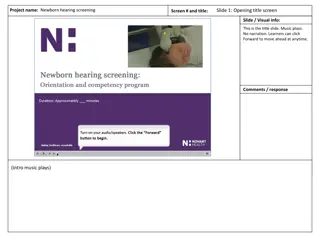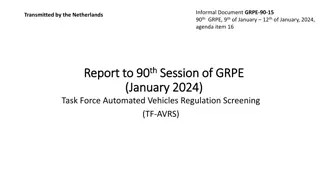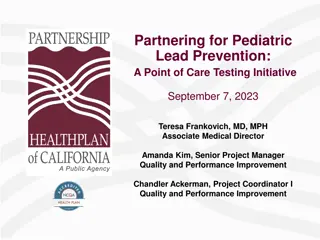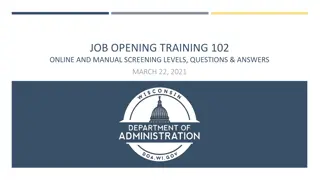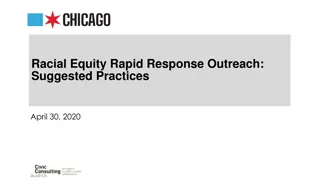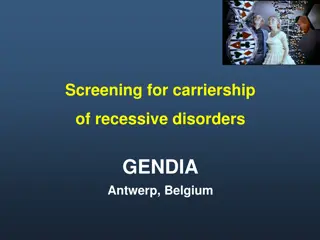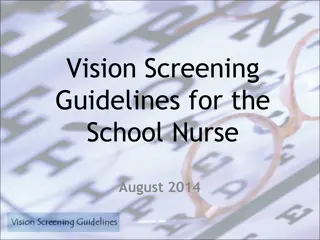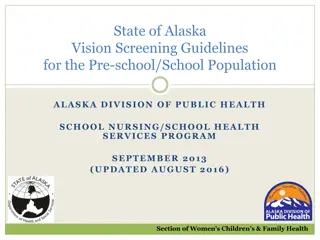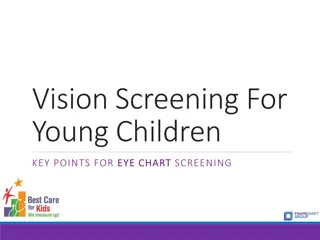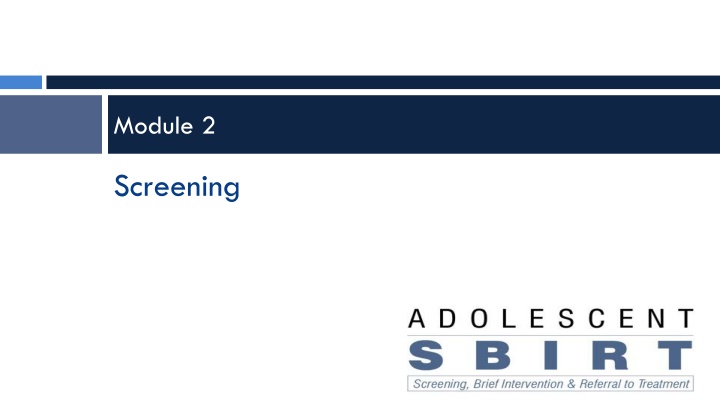
Risky Adolescent Alcohol Use
Explore the concept of risky adolescent alcohol use based on screening tools like CRAFFT, AUDIT, and GAIN-SS. Learn about the different risk levels and patterns of substance use among adolescents to effectively identify and address potential issues.
Download Presentation

Please find below an Image/Link to download the presentation.
The content on the website is provided AS IS for your information and personal use only. It may not be sold, licensed, or shared on other websites without obtaining consent from the author. If you encounter any issues during the download, it is possible that the publisher has removed the file from their server.
You are allowed to download the files provided on this website for personal or commercial use, subject to the condition that they are used lawfully. All files are the property of their respective owners.
The content on the website is provided AS IS for your information and personal use only. It may not be sold, licensed, or shared on other websites without obtaining consent from the author.
E N D
Presentation Transcript
Module 2 Screening
Presenters & Acknowledgements PRESENTERS ACKNOWLEDGEMENTS This module is based on materials from the Adolescent SBIRT Learner s Guide developed by NORC at the University of Chicago with funding from the Conrad N. Hilton Foundation. Text: TBD Subtext: TBD Text: TBD Subtext
Learning Objectives 1. Learn how to administer, score and interpret the CRAFFT, AUDIT and AUDIT-C, GAIN-SS and S2BI. 2. Practice conducting screening.
Suggested Readings Winters KC, Kaminer Y. Screening and assessing adolescent substance use disorders in clinical populations. Journal of the American Academy of Child & Adolescent Psychiatry. 2008;47(7):740-744. Winters KC. Assessment of alcohol and other drug use behaviors among adolescents. In: Allen, JP, Columbus, M, Fertig, J, eds. Assessing Alcohol Problems: A Guide for Clinicians and Researchers 2ndedition. Bethesda, MD: NIAAA; 2003:101-123. CRAFFT: Massachusetts Department of Public Health Bureau of Substance Abuse Services. Provider Guide: Adolescent Screening, Brief Intervention, and Referral to Treatment Using the CRAFFT Screening Tool. Boston, MA: Massachusetts Department of Public Health; 2009. AUDIT: Babor TF, Higgins-Biddle JC, Saunders JB, Monteiro MG. The Alcohol Use Disorders Identification Test: Guidelines for Use in Primary Care. Geneva: World Health Organization; 2001. S2BI: Levy S, Shrier L. Adolescent SBIRT Toolkit for Providers. Boston, MA: Boston Children's Hospital; 2014.
Common Screening Tools Learn ho Screening Tool Target Population Method of Cost Administration Paper and electronic; interview CRAFFT Adolescents under the age of 21 Publically available AUDIT-C and AUDIT Adolescents, Young Adults and Adults Paper and electronic; interview Publically available GAIN-SS Adolescents and Adults Paper and electronic; interview Licensing costs $100 per agency and covers giver years of unlimited use of paper assessments. See http://www.gaincc.org/prod ucts-services/licensing/ S2BI Adolescents Paper and electronic; interview Publically available
Risky Adolescent Alcohol Use The American Academy of Pediatrics has identified four general patterns of substance use based off the CRAFFT screening tool that is described in further detail later: Low Risk (Abstinence): Adolescents who report no use of tobacco, alcohol or other drugs and report that they have not ridden in a car with a driver who has been using alcohol or other drugs. Driving Risk: Adolescents who report driving after alcohol or drug use or riding with a driver who has been using alcohol or other drugs. Moderate Risk: Adolescents who have begun using alcohol or drugs (CRAFFT score 0 or 1) High Risk: Adolescents who use alcohol or drugs (CRAFFT score 2)
Risky Adolescent Alcohol Use Another way to assess the level of adolescent risk was created by the National Institute on Alcohol Abuse and Alcoholism (NIAAA). Both the number of drinking days in the past year and the age of the individual are taken into consideration to determine risk.
Asking about Alcohol and Drug Use Regardless of the tool used, asking about alcohol or other drug use may be especially difficult with adolescents who may not want to admit or discuss substance use. Successful screening can be enhanced by the memorization of the tools and practice of the conversation skills required to put the adolescent at ease. Introducing the conversation about substance use and screening is a good skill for any practitioner to practice in order to naturally transition into administering a screening tool.
Starting the Conversation How you discuss substance use with the adolescent is important. You could introduce the topic by saying one of the following: In order to help you get the correct services, I would like to ask you some questions about your health that I ask all of my clients/patients. These questions will help me to get to know you and provide you with the services you need. Is that ok? As a way to help me get to know you, I would like to ask you some questions that I ask all of my clients/patients. Is that ok?
Conversation Continued If the adolescent questions asking about substance use, you could respond: I ask everyone about their use of alcohol, tobacco and other substances. It helps me better understand your concerns and the things that may come up in any work we do together. The information you tell me is confidential. I will not disclose your answers to your parent. After the adolescent consents, you may say: Now I am going to ask you some questions about your use of alcohol and other drugs during this past year.
Confidentiality Research has shown that adolescents who are aware of confidentiality are more willing to seek health care compared to their peers who may not have the same confidentiality. State laws govern minor patient rights to confidentiality of information shared with health care providers about alcohol and drug use, but states vary as to whether or not a minor can confidentially receive drug treatment services. You should explain the full confidentiality policy regarding the disclosure of sensitive issues directly to the adolescent at the very beginning of the screening or assessment. If the adolescent is willing it can be helpful to explain the confidentiality policy to both the adolescent and the parent or guardian at the same time.
Conveying Confidentiality - Example 1 Everything you tell me will be confidential unless I hear that you re harming yourself or someone else, or you tell me you ve been a victim of abuse. I will keep our conversation about your alcohol or other substance use between us unless you agree to include your parents. Do you have any questions for me about confidentiality and its limits? One example of how you might convey an assurance of confidentiality is by saying:
Conveying Confidentiality - Example 2 Thank you completing the form and for your honesty on it. I d like to tell you about our confidentiality policy. I ll keep the details of what we discuss today confidential, which means I won't share anything with your parents. The limit of confidentiality is safety, so if you tell me something that makes me think you are at risk of hurting yourself, hurting someone else, or someone is hurting or abusing you I would have to share that information with proper health officials to make sure everyone is kept safe. Do you have any questions about how that works?"
Confidentiality Steps can be taken to ensure confidentiality including establishing private time for: Screening and discussing results Conducting a brief intervention Talking about referral Conducting follow-up visits and phone calls Discuss any procedures that may break confidentiality inadvertently and clarify risks of releasing medical records.
The CRAFFT The CRAFFT tool is the most popular alcohol and drug use screening tool for adolescents 14-21 and is recommended by the American Academy of Pediatrics Committee on Substance Abuse. The questions should be asked exactly as they are written to ensure accuracy of the screening. The CRAFFT and all validated screening tools have been tested using the specific wording and any deviation from the original wording may alter the type of response given by the adolescent.
The CRAFFT Screening Questions It is a mnemonic acronym where each first letter represents a key word in the six screening questions: C- Have you ever ridden in a CAR driven by someone (including yourself) who was "high" or had been using alcohol or drugs? R-Do you ever use alcohol or drugs to RELAX, feel better about yourself, or fit in? A- Do you ever use alcohol/drugs while you are by yourself, ALONE? F -Do you ever FORGET things you did while using alcohol or drugs? F-Do your family or FRIENDS ever tell you that you should cut down on your drinking or drug use? T-Have you gotten into TROUBLE while you were using alcohol or drugs?
Scoring the CRAFFT A score of 0-1 can indicate that there are no problems, however, a score of 2 or more can indicate that a more significant problem may exist and a brief intervention is indicated.
Lets Give It a Try! Role-play Exercise: Partner with someone to practice conducting screening. For this situation, one person will act as the practitioner using the CRAFFT, and one person will act as the adolescent who is seeking help for some bothersome behaviors. Use a blank CRAFFT to complete the role-play. Adolescent: You are a 15-year-old who is a freshman in high school and who just got caught coming home intoxicated after being at a party with your soccer team. Your grades have slipped lately and you ve been grounded a lot for breaking curfew.
Lets Give It a Try! Role-play Exercise: Partner with someone to practice conducting screening. For this situation, one person will act as the practitioner using the CRAFFT, and one person will act as the adolescent who is seeking help for some bothersome behaviors. Use a blank CRAFFT to complete the role-play. Adolescent: You are a 17-year-old who has been using alcohol recently and is feeling sad and unhappy. You think it s normal to feel this way but your parents do not agree. If asked, you might say something like: A lot of my friends and I go out and drink on the weekends, maybe on Thursday nights too. I don t want to stop hanging out with my friends, and my parents would kill me if they knew how much I am drinking.
AUDIT and AUDIT-C Alcohol Use Disorder Identification Test (AUDIT) is developed by the World Health Organization to detect hazardous and harmful use, as well as to identify potential alcohol dependence. Originally validated for use with adults; adapted for use with adolescents. Slightly longer than the CRAFFT, the AUDIT provides immediate information about level of risk for alcohol-related problem using 10 questions related to quantity and frequency of alcohol use, symptoms of dependence, and negative consequences of drinking. Takes 1-2 minutes to administer. The first 3 questions of the AUDIT are referred to as the AUDIT-C, where the C stands for consumption. These questions ask about quantity and frequency of alcohol use and take <1 minute to execute. The AUDIT-C can also be used by itself, as part of a larger set of screening questions, and also as a measure of tracking change in alcohol consumption over time.
Using the AUDIT and AUDIT-C Consumption (AUDIT-C Questions 1-3)
Using the AUDIT Dependence Symptoms (Questions 4-6)
Using the AUDIT Harmful Use (Questions 7-10)
Using the AUDIT-C and AUDIT To administer the AUDIT-C and AUDIT, first let the adolescent know that: With your permission, I am going to ask you some questions about your use of alcoholic beverages during the past year. Remind them that Alcohol refers to any form of alcohol, and a drink refers to a standard drink (explained in detail in Module 1). Consider using the standard drink chart as a pocket guide (visual aid). Additional language that you could use to administer the screening: Because alcohol use can affect your health and can interfere with certain medications and treatments, it is important that we ask you some questions about your use of alcohol. Your answers will remain confidential, so please be honest. Place an X in one box that best describes your answer to each question.
Scoring the AUDIT-C and AUDIT Responses to each question have a point value. Tally the points for each question to generate a total score. To score the AUDIT-C, tally the points recorded on questions 1-3 only. For adolescents: A positive response to any of the three items is a positive pre-screen. For young adults age 18+: A score of 4 for men and 3 for all women (and anyone over 65) indicates positive pre- screen and increased risk of alcohol-related problems. Positive pre-screens: Warrants further screening - ask the remaining 7 questions.
Scoring the AUDIT To score the AUDIT, add up the points for all 10 questions. For adolescents under the age of 18: The cut-off score is lower than that used for young adults (and adults). An AUDIT score above the cut-off indicates a possible substance use disorder. The risk ranges for scores are useful in understanding how hazardous the adolescent s drinking is and how best to proceed. 0 to 1 = low risk 2 = moderate risk, any problematic use, potential harms 3 or more = high risk, possible dependence
Scoring the AUDIT For young adults (and adults): An AUDIT score of 8 indicates at risk, harmful or hazardous drinking. The risk ranges for scores is useful in understanding how hazardous the drinking is and how best to proceed. 0 to 7 = low risk 8 to 19 = moderate risk, potential harms 20 to 40 = high risk, possible dependence
Scoring the AUDIT When interpreting a score using risk ranges, it is important to keep in mind that a score of 10 is not necessarily better than an 11, as both scores fall within the moderate risk range. The individual AUDIT score is not as important as determining the level of risk. Use your clinical judgment to evaluate whether someone needs further assessment, especially when the AUDIT score is at the cusp of the range thresholds.
Sample Interaction: AUDIT Screening Questions A video of a sample interaction between a young adult and the practitioner is located at: http://www.youtube.com/watch?v=RHcalohcunU Screen Shot 2011-09-09 at 5.25.24 PM.png
Lets Give It a Try! Role-play Exercise-Adolescent: Partner with someone to practice some of the techniques that you are learning. For this situation, one person will act as the practitioner using the three questions of the AUDIT-C, and one person will act as the adolescent who is seeking help for some bothersome behaviors. Use the blank AUDIT-C to complete the role-play. Adolescent: You are a 15-year-old adolescent who was recently kicked out of the school play for misbehaving. Your dad suggested that you talk to a counselor because you have been moody and unmotivated to do your schoolwork. You are angry that they might kick you out of the house if they found out that you are taking Xanax recreationally and drinking a lot (even on the weekdays). If asked, you might say something like: A lot of my friends and I go out and drink on the weekends, maybe on Thursday nights too. I don t want to stop hanging out with my friends, and my parents would kill me if they knew how much I am drinking.
Lets Give It a Try! Role-play Exercise-Young Adult: Partner with someone to practice some of the techniques that you are learning. For this situation, one person will act as the practitioner using the AUDIT, and one person will act as the young adult who is seeking help for some bothersome behaviors. Use the blank AUDIT to complete the role-play. Young Adult: You are a 19-year-old woman/man who is living with her/his parents after dropping out of college three months ago. Your mom suggested that you contact someone to talk to because you have been moody and unmotivated to get a job. You are scared that they might kick you out of the house if they found out that you are drinking a lot and taking Adderall recreationally. If asked, you might say something like: A lot of my friends and I go out and drink on the weekends, sometimes on Wednesday nights too. I don t want to stop hanging out with my friends, and my parents would kill me if they knew I was drinking so much and taking my little brother s Adderall. I don t think they even know that I smoke.
GAIN-SS The Global Appraisal of Individual Need Short Screen (GAIN-SS) is another screening tool recommended for adolescents, young adults, and adults. It takes approximately 3-5 minutes to administer and assesses level of risk for mental health and conduct problems, alcohol and/or drug use and crime or violence.
Using the GAIN-SS The GAIN-SS is introduced using this language: The following questions are about common psychological, behavioral, and personal problems. These problems are considered significant when you have them for two or more weeks, when they keep coming back, when they keep you from meeting your responsibilities, or when they make you feel like you can t go on. After each of the following questions, please tell us the last time that you had the problem, if ever, by answering. In the past month (3), 2-12 months (2), 1 or more years ago (1), or Never (0).
Scoring the GAIN-SS The GAIN- SS is scored by adding up the number of 2s and 3s for each section and then by completing the section at the end.
Lets Give It a Try! Role-play Exercise: Partner with someone to practice some of the techniques that you are learning. For this situation, one person will act as the practitioner using the GAIN-SS, and one person will act as the adolescent who is seeking help for some bothersome behaviors. Use the blank GAIN-SS to complete the role-play. Adolescent: You are a 16-year-old who has been using alcohol and marijuana, and feeling anxious at school. You know it s not normal to feel this way but not sure what else to do. You think you should talk to someone. If asked, you might say something like: My friends and I drink before school. I m less anxious with a buzz. After school we smoke a little weed. I feel happier and like I fit in. I know I m underage and pot is illegal but it makes me feel calm, less stressed out. I should probably talk to someone before I get in trouble.
S2BI Created by Boston s Children s Hospital and introduced in 2014, Screening to Brief Intervention (S2BI) is a brief, validated electronic and paper screening tool for youth aged 12-17 years. The S2BI can be self-administered or conducted as an interview. This relatively new tool begins with a single question to assess the frequency of substance use in the past year. The substances screened in S2BI are categorized into eight categories including alcohol, marijuana, cocaine and prescription drugs. It is based off of the Diagnostic and Statistical Manual of Mental Disorders (DSM-5) diagnoses for Substance Use Disorders.
Using the S2BI The interview version of the S2BI is introduced using: The following questions will ask about your use, if any, of alcohol, tobacco, and other drugs. Please answer every question. The electronic S2BI is introduced using: The following questions will ask about your use, if any, of alcohol, tobacco, and other drugs. Please answer every question by clicking on the box next to your choice.
Scoring the S2BI Ask the first three initial questions about tobacco, alcohol, and marijuana. Use the answers to these questions to determine if the remaining questions should be administered: Never to all Do not ask remaining S2BI questions; Provide positive reinforcement Once or twice Ask the remaining S2BI questions then provide brief advice Monthly and Weekly Ask the remaining S2BI questions then provide brief motivational intervention
Scoring the S2BI Frequency of using tobacco, alcohol, or marijuana Risk Level Brief intervention Never No use Positive Reinforcement Once or Twice No Substance Use Disorder Mild/Moderate Substance Use Disorder Brief Advice Monthly Further assessment, brief motivational intervention Weekly or more Severe Substance Use Disorder Further assessment, brief motivational intervention, referral
Lets Give It a Try! Role-play Exercise: Partner with someone to practice administering the S2BI. One person will act as the practitioner and the other will act as an adolescent seeking help for some bothersome behaviors. Use the blank S2BI to complete the role-play. Adolescent: You are a 13-year-old who has recently been using alcohol on the weekends and has been struggling with your new school. You don t want to talk with someone but your parents think it could be helpful, especially since you have transitioned to a new school this year.
Other Screening Tools NIAAA Youth Screening this simple, quick, empirically derived tool is used to identify risk for alcohol-related problems in adolescents ages 9-18 years. A copy of the NIAAA Youth Guide is available at: http://www.niaaa.nih.gov/Publications/EducationTrainingMaterials/Pages/ YouthGuide.aspx Adapted NIDA-Modified ASSIST Screening Tool this simple, quick tool can be used with adolescents and young adults age 11-17 years old to assess use of alcohol, tobacco, drugs, and prescription medications for non- medical reasons. A copy of the Adapted NIDA-Modified ASSIST is available at: http://www.drugabuse.gov/nidamed-medical-health- professionals/tool-resources-your-practice/screening-assessment-drug- testing-resources/american-psychiatric-association-adapted-nida A summary of adolescent screening tools are included in the NIAAA published resource, Assessing Alcohol Problems: A Guide for Clinicians and Researchers.See chapter 5 for adolescent measures. http://pubs.niaaa.nih.gov/publications/AssessingAlcohol/index.pdf

